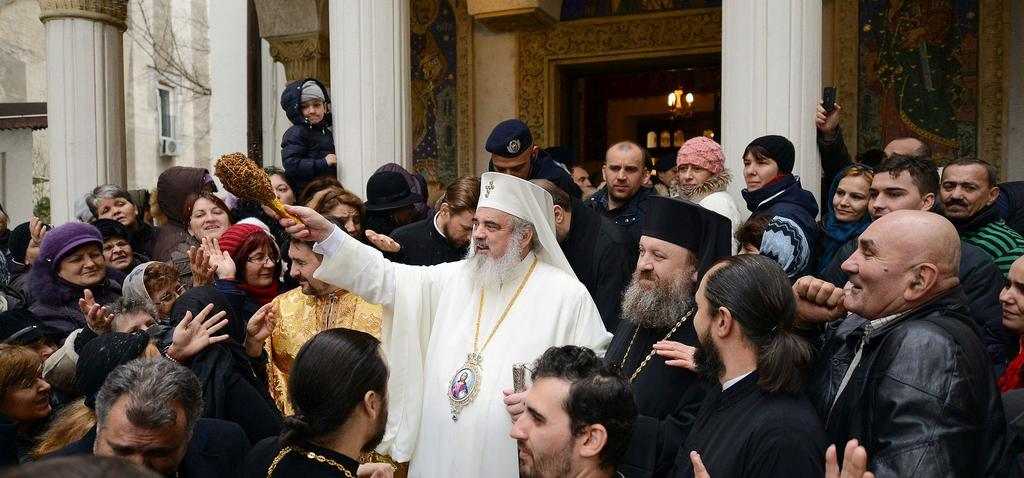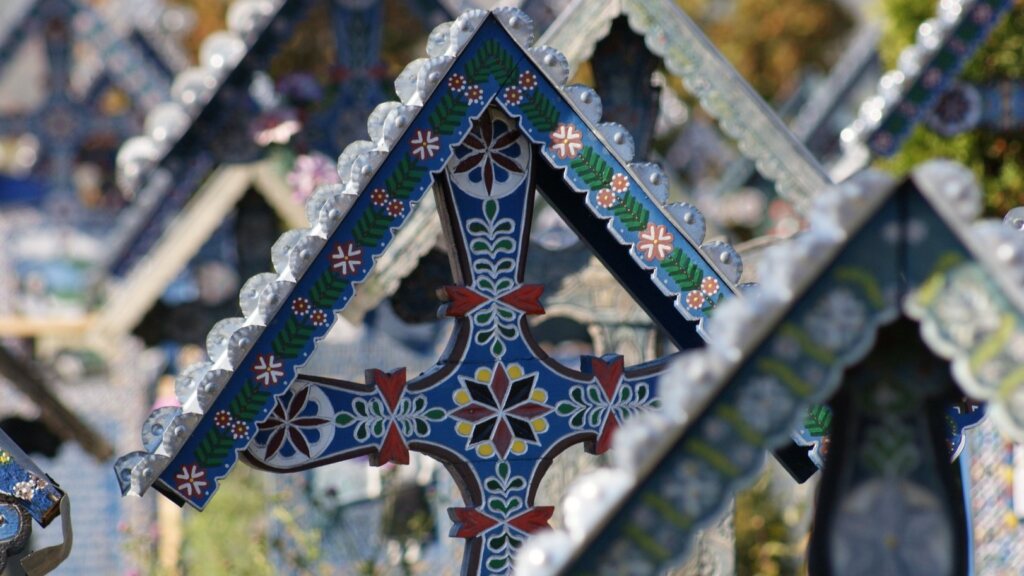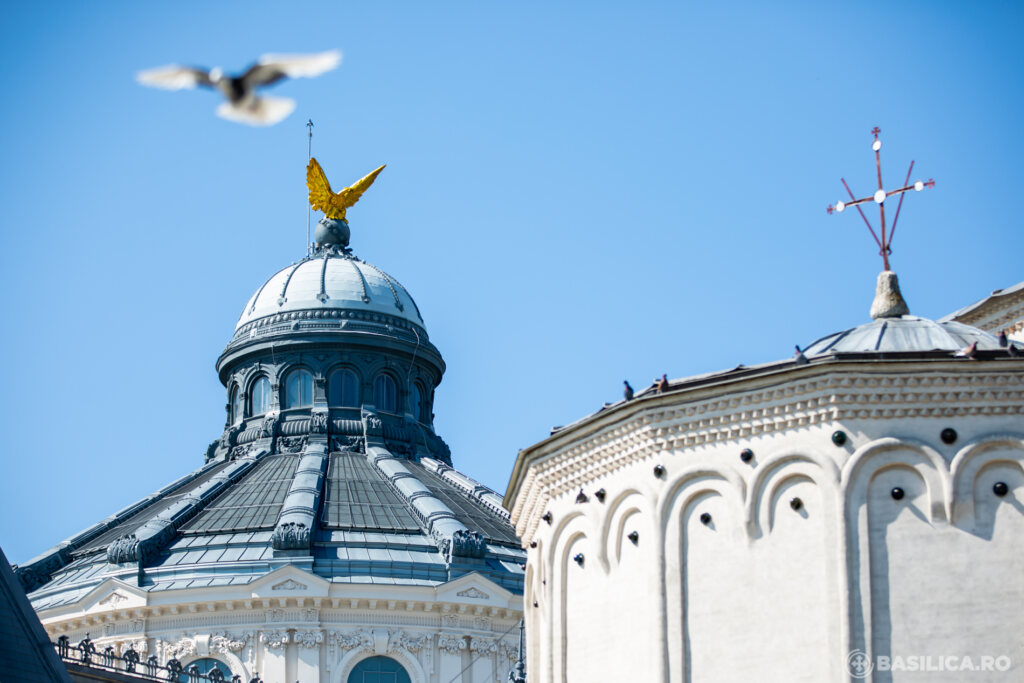Today, 23 November 2014, His Beatitude Daniel, Patriarch of Romania, blessed the painting and altar screen of “Saint John” – Square church, district 3, Bucharest. The religious service was preceded by the Divine Liturgy celebrated by His Grace Timotei Prahoveanul, Assistant Bishop to the Archdiocese of Bucharest, with the blessing the Patriarch of Romania, assisted by a group of priests and deacons, in the presence of hundreds of faithful.
Present in the middle of the faithful of “Saint John” – Square parish, His Beatitude Patriarch Daniel delivered a sermon within the Divine Liturgy referring to the evangelical pericope scheduled for this Sunday, on the Rich man with good crop, full of teaching for our spiritual ascension to the great feast of the Nativity of the Lord: “In the Holy Scriptures, the richness or poverty are not a purpose in itself, but they can be an opportunity of rapprochement or alienation from God and from one’s fellow beings. This is why the Holy Gospel on the rich man whose land produced abundantly ends with these words: “This is how it will be with whoever stores up things for themselves but is not rich toward God.” The Gospel shows us that greed brings about man’s decay and loneliness. The parable of the rich man whose land produced abundantly does not refer to a certain man, but to the greedy rich man, discontented and merciless, who can be any man whose soul is attached exclusively to the temporary limited things of this world. Wealth is not bad in itself, but the way it is used can be good or bad.”
The Patriarch of Romania has also spoken about the results of the sin of greed: “Unlike the mercy that can bring joy, greed for material wealth often caused quarrels between neighbours, friends and relatives. Sometime trials, fights or even murders occur. Unfortunately, lots of wars between peoples were caused especially by the greed and by the spirit of domination of some people over others. Poverty, if not changed into effort of spiritual enriching of the human’s life in communion with God, brings about much evil, like envy, rebellion, hate, theft, violence, despair. Therefore, the Gospel of the day is a light on the way of using wealth as a gift of God which the rich man must share with the poor people. The Romanian people sums up this truth in the following words inspired by the Gospel: “a gift from another gift turns into heaven”.
The Gospel also shows us the treasures which can enrich us spiritually: “But the Gospel also shows us there is another way of enriching but with the temporary material wealth, namely the spiritually enriching in God, namely the enriching of the soul with spiritual gifts cultivated as virtues of souls: faith, love, hope, lowliness, patience, generosity a.s.o.”, His Beatitude also said.
Mercy has always been a priority for the Orthodox Church: “The Church urges the rich to be merciful and the poor to pray of the help of the Merciful God. For example, in Byzantium, the emperor visited the poor old people’s homes on the week of the Holy Passions of Jesus Christ, our Lord. Then, the emperor offered a lot of money to the Church so that she could organise her charitable work for the needy. The Romanian Orthodox Church has also urged the leaders, princes, boyars and all the wealthy people to be charitable, to help the poor because Christ, our Lord, mysteriously comes to us through them. Thus, in the Romanian Principalities, the first hospitals, old people’s homes, orphanages and houses for pilgrims were organised by the Church, very often with the support of the rich merciful people.”
After the Divine Liturgy, the Patriarch of Romania blessed the painting and altar screen of the church of “Saint John” – Square. Besides His Beatitude, His Grace Timotei Prahoveanul and a group of priests and deacons were also present.
To end with the celebration, His Beatitude Daniel delivered a sermon in which he showed the hostilities the church of “Saint John” – Square suffered during the communist regime. “This church was crucified through its moving in 1986. It was situated close to the square, and although small, its central place and visibility disturbed. It was not demolished, killed, but crucified through its moving from its original place and situated here, where we see it today. Later on, it was surrounded by blocks of flats so that today it can still be seen only if we look very attentively. Now, this church is a symbol for our city of the period in which the Romanian Orthodox Church lived, especially in Bucharest, during the atheist communism, demolisher of souls and churches. Now it has reached its first beauty again, even increased through the equipment given”.
His Beatitude underlined the symbolic spiritual value of the renovation of the painting and altar screen of a church: “The renovation of the altar screen and of the painting is not only a technique and aesthetic process, but also a spiritual one, especially during the fasting periods. The renovation of the altar screen and the cleaning of the painting to reach its first beauty have symbolic value. These works call us too to restore the image of God in us and renew our Christian life after sin tarnished our soul and the clean vestment of the baptism with its stains, smoke, dust and soot. In order to restore the image of God in the human and to bring our spiritual life back to the state of its first beauty we cannot use paint or chemic substances, but something much easier to find, but more difficult to do. We clean our soul with the tears of repentance; we restore the Christian life in us, and come back to the beauty of the baptism.”
The Patriarch of Romanian spoke both about the importance of the restoration of the old churches, and about the need to raise some new ones: “Besides the new churches we are building, having been a must for the faithful, we have to think of the restoration of the old churches historical monuments and of the furniture with patrimonial value. Churches have been built, but they are still few. Only 10-15% of the population of the city can be accommodated in the churches present today. This thing shows us that although many churches are full, they are not enough if all the Orthodox Christians of Bucharest, 1,700,000 registered at the census, came to the church every Sunday and feast day. Not very many people attend the celebrations.
Then, His Beatitude Patriarch Daniel awarded parish priest Anatolii Scurtu the rank of iconom stavrofor and that of iconom to servant priest Mihail Badita Birnea. His Beatitude has also awarded the Order of “Sanctus Stephanus Magnus” for clergy to father Ionut Badea, servant priest at “Saint John” – Square church, and the Diploma of the “Brancovean Saints Martyrs” to deacon Sorin Eusebiu Argintariu, servant priest at this church, as well as to founders Eugenia Nicolae and Ion Savancea. Prof Engineer Dr Eugen Iordachescu was awarded the Distinction of worthiness of the image of Saint Dimitrios the New, Protector of Bucharest, for having worked out the technical solution to move the church on 23 metres in 1986 and so to save it. The same distinction was awarded to the Parochial Council. His Beatitude has also awarded the Distinction of worthiness of the image of the Mother of God to the parochial committee, to jurist Elena Scurtu, and to Ecaterina Paula Erhan – expert restorer.
The Patriarch of Romania offered a blessing cross made at the Workshops of the Romanian Patriarchate and several liturgical and theological books to the place of worship and small icons of Saint John the Baptist, protector of the church, to the faithful present. Parish priest Anatolii Scurtu offered His Beatitude a wooden icon of Saint John the Baptist and a bunch of flowers as a sign of thanksgiving.
The church of “Saint John” – Square dates from 1766, it was built – with the blessing of Metropolitan Grigorie – by Ionita Croitorul, chief of the dyers and furriers of the city, with his men, and it was dedicated to the “Beheading of Saint John the Baptist”. From an architectural point of view, this church is built in a style with influences of the 17th century, ship shaped, with the semi-circular apse of the altar, two belfries and columns at the entrance, making a narrow exo-narthex. The place of worship keeps the relics of several saints, among which those of Saint Philip the Apostle.






